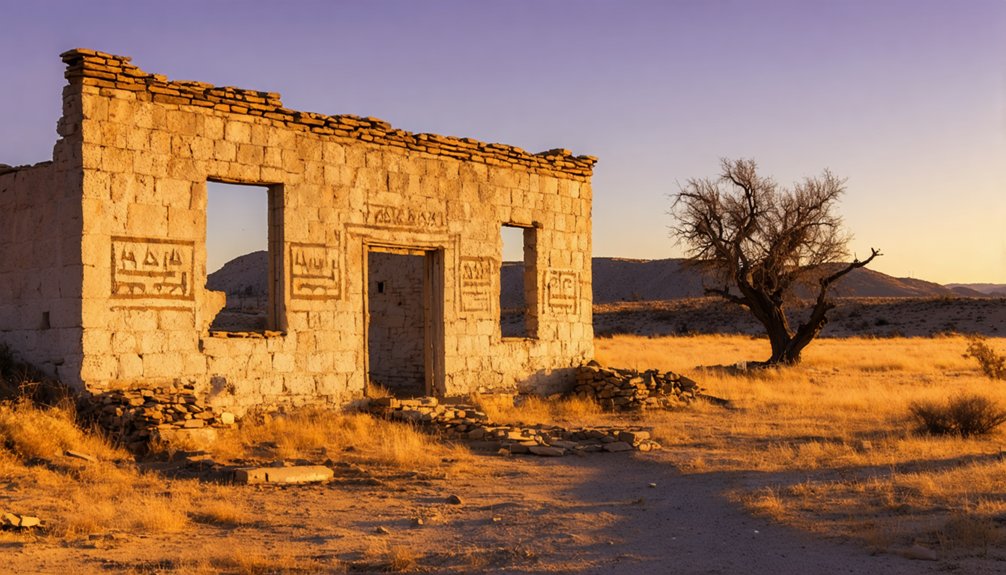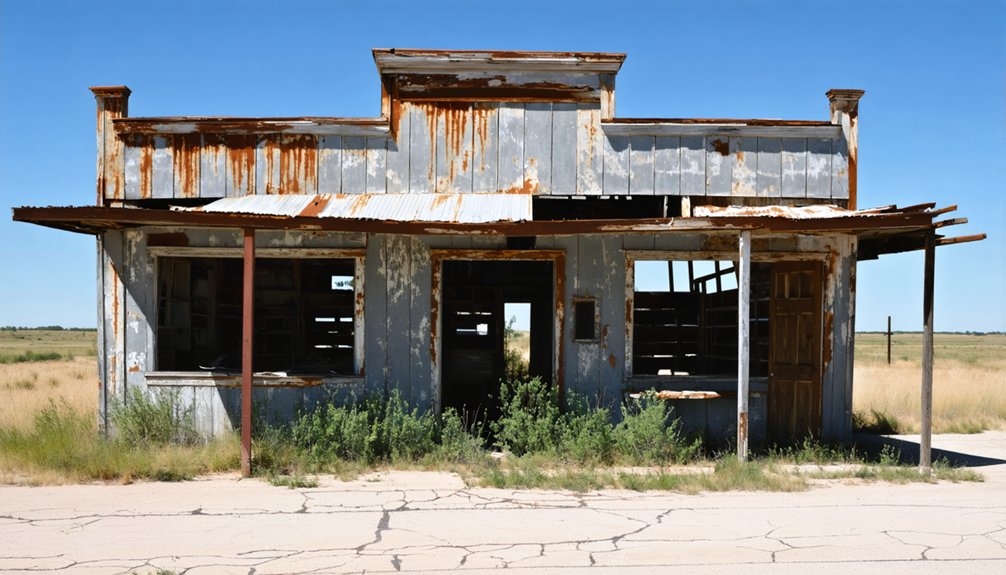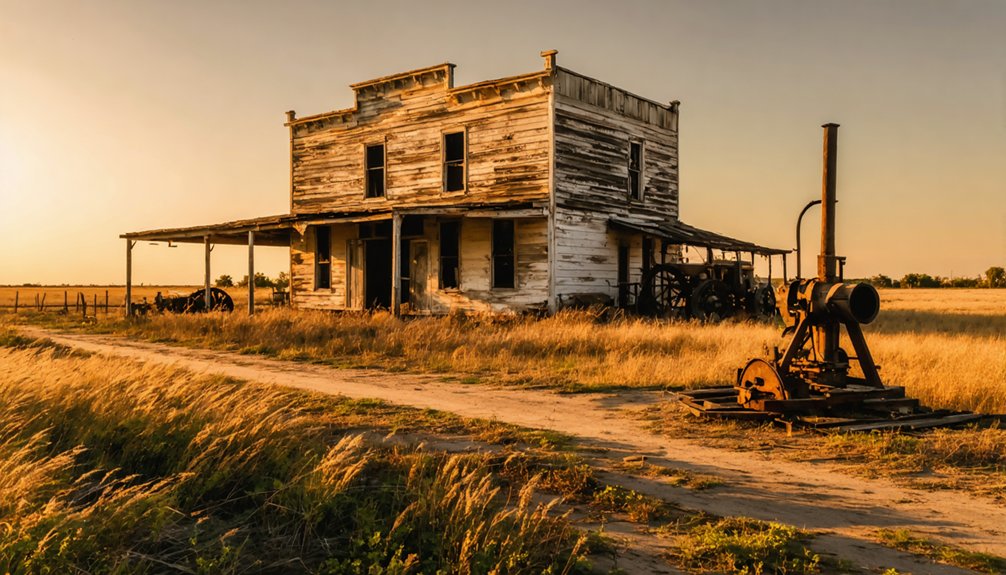You’ll find Quihi, a German-Texan ghost town, 30 miles west of San Antonio in Medina County. Founded by Henri Castro in 1844, ten pioneer families established this settlement in March 1845, building limestone homes and facing frequent Comanche raids. The town’s legacy lives on through the historic Quihi Dance Hall (built 1890) and Bethlehem Lutheran Church (1852). Today’s quiet streets and preserved structures tell fascinating tales of frontier survival and cultural resilience.
Key Takeaways
- Quihi began as a German settlement in 1844, founded by Henri Castro, and is now considered a ghost town west of San Antonio.
- The town’s historic Quihi Dance Hall, built in 1890 on stilts, remains active and represents the settlement’s German cultural heritage.
- Economic decline struck in the early 1900s when boll weevils devastated cotton crops, leading to population loss and abandonment.
- The Bethlehem Lutheran Church, established in 1852, stands as a preserved landmark of the former community’s religious center.
- Original limestone structures and the Quihi Gun Club, America’s oldest shooting club, remain as testaments to the settlement’s frontier history.
The Birth of a German-Texan Settlement
As Henri Castro surveyed the Texas Hill Country in 1844, he identified the future site of Quihi, situated 30 miles west of San Antonio in Medina County. By March 1845, ten determined families of German and French descent arrived by oxcart from Indianola seaport, ready to forge their own destiny on this untamed frontier.
You’ll find Quihi’s establishment was part of Castro’s broader vision for cultural integration, creating a network of German-Texan settlements including nearby Castroville. Like many German settlers of the era, they endured arduous journeys lasting over three months from their homeland.
These pioneers faced immigrant challenges head-on, bringing their unique architectural styles and cultural traditions. They built homes from native limestone and sandstone, established 20-40 acre farming plots, and maintained their European village layout sensibilities. Early settlers focused on cultivating stock and corn, which became the foundation of their agricultural economy.
Determined settlers shaped their slice of Texas, building limestone homes and small farms while preserving their European village heritage.
Texas Rangers accompanied these settlers, providing protection as they carved out their new lives in this promising yet demanding landscape.
Life on the Texas Frontier
During your first years in Quihi, you’d find yourself facing the harsh realities of frontier life, including frequent Comanche raids that forced settlers to maintain constant vigilance.
You’d join other German pioneers in constructing defensive structures and organizing community watches, as the military presence at nearby Fort Richardson couldn’t always respond quickly enough to threats. Much like the Buffalo Soldiers stationed at frontier outposts, settlers had to remain ready to defend their territory at all times.
Despite these challenges, you’d work alongside your neighbors to establish permanent homesteads, sharing resources and labor to build stone houses, plant crops, and create a sustainable German-Texan community in the wilderness. New families arriving in Quihi often participated in community quilting bees and dances to maintain social bonds despite the isolation.
Defending Against Indian Raids
While settlers established new communities across the Texas frontier, Indian raids posed a devastating and persistent threat to their survival.
You’d find Comanche and Kiowa raiding strategies particularly lethal, as they’d strike settlements with overwhelming force, killing settlers and destroying property. The 1864 Elm Creek raid saw six hundred warriors decimate fourteen frontier families. Chief Buffalo Hump assembled at least 400 warriors for devastating raids against Texas settlements.
In response, you’d need multiple layers of settler defenses: stockades for refuge, armed civilians ready to fight, and early warning systems to detect approaching warriors.
If raiders attacked, you could retreat to water like the survivors of Linnville did, since many Native warriors weren’t skilled in aquatic pursuit.
You’d also rely on Texas Rangers and volunteer companies to guard your community and chase down raiding parties.
Despite these measures, the threat remained constant through the Civil War era, with raids causing widespread destruction and civilian casualties.
Building Pioneer Communities
Through the 1820s and beyond, you’d find Texas frontier communities emerging from ambitious land grant programs initiated by Spanish and Mexican authorities.
You’d face pioneer challenges like securing essential supplies from distant trading posts, often traveling for months by mule or wagon through dangerous territory. To overcome these obstacles, you’d need smart settlement strategies: building near water sources, establishing protective structures, and forming tight-knit communities around military posts. You’d find essential guidance from empresarios like Austin who helped organize new settlements. Settlers welcomed travelers with open-door hospitality, creating strong bonds across the isolated frontier.
You’d join other settlers in constructing homes from local materials while building churches and schools to strengthen community bonds.
With the population exploding from 20,000 in 1830 to over 140,000 by the late 1840s, you’d witness the transformation of isolated homesteads into organized towns, supported by supply freighters and frontier forts that guaranteed your community’s survival.
Defending the Settlement
After establishing Quihi in 1846, the early settlers faced immediate defensive challenges from Native American groups who launched multiple attacks on the fledgling settlement.
The pioneers quickly formed a local militia and developed survival strategies to protect their newly claimed territory.
You’ll find evidence of their defensive ingenuity in three key areas:
- Limestone cottages built in European style for enhanced protection
- Strategic use of Quihi Lake’s geography for surveillance
- Coordinated defense efforts among the original ten founding families
The ten original families who traveled from Indianola seaport established the initial defensive perimeter of the settlement.
The settlement’s defensive capabilities strengthened through community institutions like churches and the Quihi Gun Club, which served dual purposes of protection and social cohesion.
These early security measures proved effective, allowing the settlement to persist despite ongoing frontier tensions throughout the 19th century.
Led by Henri Castro, the settlement’s colonists were part of a larger German-French immigration movement to Texas.
Cultural Heritage and Traditions
You’ll find Quihi’s German heritage remarkably preserved in the limestone structures and the Bethlehem Lutheran Church, which has anchored the community since its 1846 founding.
The historic Quihi Gun Club, established in 1890 as a Schuetzen Verein, continues to host monthly dances and remains America’s oldest continuously operating shooting club.
The Lutheran congregation maintains strong ties to its German roots through religious services and cultural events, reflecting the settlement’s enduring European traditions despite its ghost town status.
German Roots Still Standing
While many Texas ghost towns have lost their cultural identity over time, Quihi’s German heritage remains remarkably intact since its 1845 founding by ten pioneering families. The settlement’s cultural continuity is evident in its preserved German architectural traditions and the many descendants of original settlers who still call this place home.
- Traditional German building techniques shine through in the limestone structures with lime-plastered exteriors and adobe interior walls.
- The town’s layout mirrors European village designs, with clustered town lots surrounded by farming plots.
- Heritage languages and customs have persisted through generations, passed down through family lines.
Today, despite preservation challenges from mining and noise pollution, Quihi stands as a symbol of the enduring spirit of its German founders and their determination to maintain their cultural identity in the Texas frontier.
Dance Hall Legacy Lives
Since 1890, the historic Quihi Dance Hall has anchored the town’s cultural life as part of the Quihi Schuetzen Verein, one of America’s oldest continuously operating gun clubs.
You’ll find this unique dance hall perched 6 feet above Quihi Creek on sturdy stilts, a demonstration of German engineering that’s weathered countless floods.
On the second and fourth Saturdays of each month, you can experience the cultural significance of this non-air-conditioned hall, where Texas legends like Pappy Selph once played.
The venue’s renowned wooden dance floor, considered among Texas’ finest, draws dancers from across the globe.
While the gun club maintains its traditional male-only membership of 600, the dance hall welcomes everyone for public dances, weddings, and family reunions, keeping Quihi’s rich heritage alive.
Lutheran Community Connections
Beyond the rhythmic sounds of the dance hall, Quihi’s cultural heart beats strongest through the Bethlehem Lutheran Church, established in March 1852 under Rev. Christian Oefinger.
You’ll discover a rich tapestry of German heritage woven through Lutheran traditions that settlers brought from Württemberg, Hanover, and other regions.
- The church hosted three Texas Synod meetings before 1894, cementing its role as a regional Lutheran stronghold.
- The Lindeburg School, opened in 1856, strengthened the community’s cultural bonds through education.
- Community gatherings preserved German customs, language, and religious rites passed down through generations.
This spiritual center continues to stand as a reflection of the pioneering families who created a tight-knit religious community in the Texas frontier, maintaining their distinct cultural identity through faith and fellowship.
The Historic Quihi Dance Hall
Standing as a tribute to German-Texan cultural heritage, the Quihi Dance Hall emerged in 1890 when two German settlers established it as part of the Quihi Schuetzen Verein (shooting club).
Originally built as a defensive structure, it’s now elevated on 6-foot cedar stilts to protect against Quihi Creek’s flooding while enhancing the dance floor’s spring.
You’ll find distinctive dance hall architecture featuring a wooden floor that’s considered among Texas’s finest, topped by a corrugated tin roof.
The hall continues to host bi-monthly dances, maintaining its status as one of America’s oldest operating social clubs. Texas music legends like Pappy Selph and Cliff Bruner have graced its stage, contributing to the venue’s rich musical heritage.
Today, the 600-member men’s club preserves this cultural landmark while welcoming public events and weddings.
Native American Relations

Prior to European settlement in 1845, Lipan Apache and Comanche groups regularly traversed the Quihi area, using its abundant resources for seasonal hunting and raiding.
When Henri Castro’s Alsatian settlers arrived, cultural interactions quickly turned violent, with two settler families killed within the first week.
The harsh realities of frontier life in Quihi included:
- Persistent indigenous raids targeting livestock, supplies, and settlers through the 1870s
- Fortified village layouts adopted by settlers for protection against attacks
- Limited peaceful exchanges, though indigenous influences remained in local features like Quihi Creek’s name
Despite the primarily adversarial relationship, you’ll find traces of shared history in the settlement’s name itself, derived from a bird call noted by both indigenous peoples and settlers – a rare instance of cultural observation during this tumultuous period.
Daily Life in Early Quihi
Life in early Quihi centered around ten pioneer families who established their settlement near Quihi Lake in 1845. As a settler, you’d have spent your days working the fertile land, raising livestock, and maintaining a self-sufficient homestead alongside your German, Alsatian, and East Frisian neighbors.
Your daily routines would’ve revolved around farming tasks, while staying alert for Native American raids that persisted until the 1870s. Community support proved essential – you’d gather with neighbors for religious events and harvest festivals, sharing resources and helping each other through challenging times.
You’d communicate in various German dialects and English, creating a unique linguistic blend. While Texas Rangers provided some protection, you’d still need to remain vigilant while tending to your crops and animals near Quihi Creek.
The Path to Abandonment

Although Quihi began with optimistic settlers in 1846, its path toward abandonment started in the early 1900s when the boll weevil devastated the town’s cotton-based economy.
Without economic resilience, the community’s decline accelerated as farmers struggled to adapt with alternative crops.
Lacking financial stability, Quihi’s farming community faltered when shifting to new crops proved an insurmountable challenge.
The town’s isolation sealed its fate in three distinct ways:
- No railroad access limited trade opportunities and market reach
- San Antonio’s proximity drew younger residents away for better prospects
- Agricultural mechanization reduced the need for small farming communities
Preserving Quihi’s Memory
Despite ongoing preservation efforts, Quihi’s historical legacy faces mounting challenges from industrial development and structural deterioration.
While Preservation Texas recognized Quihi as a historic resource district in 2006, the settlement lacks formal protection against threats like the planned 50-year limestone mining operation that’ll extract 200 million tons nearby.
You’ll find original European-style limestone cottages from 1846 still standing, though they need restoration.
Memory preservation depends on community engagement through educational programs and local tours. School groups visit to learn about settler life, while descendant families of original settlers lead history projects.
The loss of the Stormhill Schoolhouse to demolition shows what’s at stake.
Without stronger preservation measures, Quihi’s remaining structures and cultural heritage remain vulnerable to commercial pressures and physical decay.
Frequently Asked Questions
What Was the Average Land Price per Acre in Quihi During 1845?
You can’t pinpoint exact historical pricing for 1845 Quihi land value, though it likely matched other Texas colonization rates of nominal fees to several dollars per acre under Castro’s settlement program.
How Many Original Settler Families’ Descendants Still Live in the Area Today?
While exact descendant demographics aren’t specified, you’ll find that many of Quihi’s roughly 200 current residents maintain family lineage from the original 10 settler families who arrived in 1845-1846.
What Crops Were Primarily Grown by the Early German Settlers?
Like seeds scattered across fertile soil, you’ll find German agriculture centered on corn and wheat, with sorghum, oats, and barley following smart crop rotation practices. Cotton and vegetables rounded out their harvests.
When Was the Last Documented Native American Raid on Quihi?
You won’t find a precise date for the last Native American raid on Quihi, as historical records are incomplete. The area’s historical significance includes raids, but specifics weren’t well-documented during frontier times.
What Was the Peak Population of Quihi Before It Became a Ghost Town?
You won’t find exact peak population records due to the historical significance of this frontier settlement. The highest documented count was around 100 residents in the 1960s before population decline began.
References
- https://www.youtube.com/watch?v=EcKNorOzxtk
- https://www.ksat.com/news/local/2023/03/21/ksat-explains-from-the-archives-we-take-a-look-back-at-the-best-of-how-did-that-town-get-its-name/
- https://www.hmdb.org/m.asp?m=64185
- https://www.ghosttowns.com/states/tx/quihi.html
- https://texashillcountry.com/hill-country-ghost-towns-explore/
- https://www.tshaonline.org/handbook/entries/quihi-tx
- https://www.texasescapes.com/TexasHillCountryTowns/Quihi-Texas.htm
- https://en.wikipedia.org/wiki/Quihi
- https://www.tshaonline.org/handbook/entries/medina-county
- https://dallasgenealogy.org/DGS_Docs/GermanSIG/Handouts/2021_09_Early_German_Settlements_in_Texas_1831-1860.pdf



